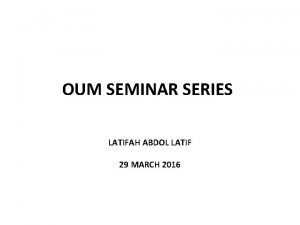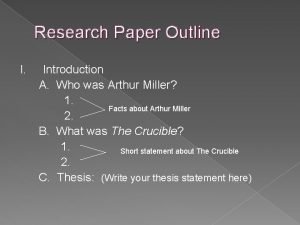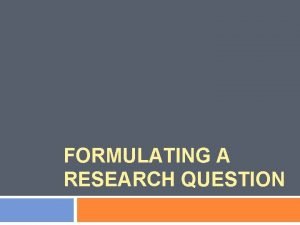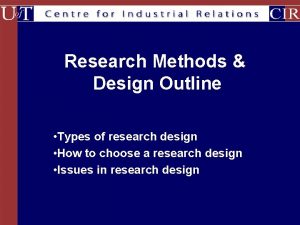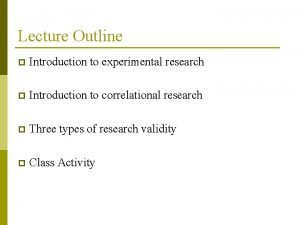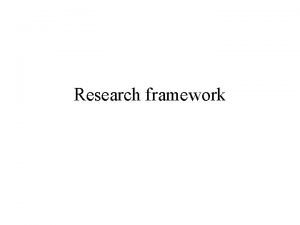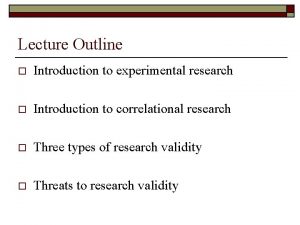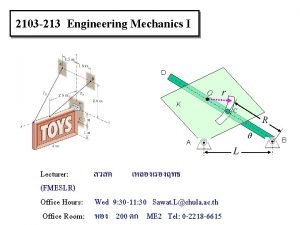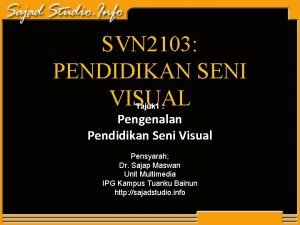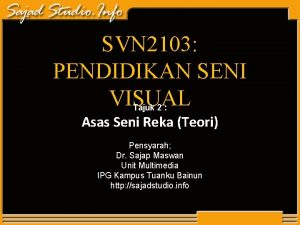Outline Lecture 3 Jan 2103 Chapter 3 Research
![Outline: Lecture 3 – Jan. 21/03 [Chapter 3 - Research] • • • The Outline: Lecture 3 – Jan. 21/03 [Chapter 3 - Research] • • • The](https://slidetodoc.com/presentation_image_h/0dfdcd80a867d268f53b40be80fd1a1a/image-1.jpg)




![Forms of Measurement [cont’d] 2. Psychophysiology and Neuro-imaging – physiological responses recorded include: heart Forms of Measurement [cont’d] 2. Psychophysiology and Neuro-imaging – physiological responses recorded include: heart](https://slidetodoc.com/presentation_image_h/0dfdcd80a867d268f53b40be80fd1a1a/image-6.jpg)
![Forms of Measurement [cont’d] 3. Observation – may range from unstructured, naturalistic observations to Forms of Measurement [cont’d] 3. Observation – may range from unstructured, naturalistic observations to](https://slidetodoc.com/presentation_image_h/0dfdcd80a867d268f53b40be80fd1a1a/image-7.jpg)






![General Approaches to Research [cont’d] • Prospective vs Retrospective Research – Real-time prospective designs: General Approaches to Research [cont’d] • Prospective vs Retrospective Research – Real-time prospective designs:](https://slidetodoc.com/presentation_image_h/0dfdcd80a867d268f53b40be80fd1a1a/image-14.jpg)












- Slides: 26
![Outline Lecture 3 Jan 2103 Chapter 3 Research The Outline: Lecture 3 – Jan. 21/03 [Chapter 3 - Research] • • • The](https://slidetodoc.com/presentation_image_h/0dfdcd80a867d268f53b40be80fd1a1a/image-1.jpg)
Outline: Lecture 3 – Jan. 21/03 [Chapter 3 - Research] • • • The Scientific Approach The Research Process Common Research Topics Forms of Measurement Defining Research Terminology General Approaches to Research Designs Research Methods Qualitative Research Ethical Issues

The Scientific Approach • Theory - propositions that explain phenomena. • Hypothesis – an educated guess; a tentative assumption • Purpose of Scientific Approach: to describe phenomena and offer explanations for them. • Reasons for skepticism of research: » experts will often disagree » research findings are often in conflict » research will sometimes lead to different recommendations » research conclusions are often qualified

The Research Process

Common Research Topics 1. Nature & Distribution of Childhood Disorders 2. Risks, Causes, and Correlates 3. Moderating and Mediating Variables – See Figure 3. 3 in text 4. Outcomes associated with childhood problems 5. Interventions – Treatment efficacy – Treatment effectiveness

Forms of Measurement 1. Reporting – includes unstructured clinical interviews, highly structured interviews, and questionnaires – inaccuracies may occur because of inability to recall events, selective recall or bias, and intentional distortions – requires a certain level of verbal ability, therefore often not considered reliable with children under age 7 or 8
![Forms of Measurement contd 2 Psychophysiology and Neuroimaging physiological responses recorded include heart Forms of Measurement [cont’d] 2. Psychophysiology and Neuro-imaging – physiological responses recorded include: heart](https://slidetodoc.com/presentation_image_h/0dfdcd80a867d268f53b40be80fd1a1a/image-6.jpg)
Forms of Measurement [cont’d] 2. Psychophysiology and Neuro-imaging – physiological responses recorded include: heart rate, blood pressure, respiration, pupil dilation, and electrical skin conductance – limitations of physiological measures include: inconsistency, high level of inference often involved, and susceptibility to extraneous influences – electroencephalogram (EEG) measures electrical activity of the brain – neuroimaging procedures examine the structure and/or function of the brain
![Forms of Measurement contd 3 Observation may range from unstructured naturalistic observations to Forms of Measurement [cont’d] 3. Observation – may range from unstructured, naturalistic observations to](https://slidetodoc.com/presentation_image_h/0dfdcd80a867d268f53b40be80fd1a1a/image-7.jpg)
Forms of Measurement [cont’d] 3. Observation – may range from unstructured, naturalistic observations to highly structured – compared to naturalistic observations, structured observations are often cost-effective, allow for focused attention, are useful for studying infrequent behavior, and allow for greater control over the situation – major limitation is that one cannot be certain the observations are a representative sample of behavior

Identifying the Sample • A careful definition of the sample is critical for comparability of findings across studies • Must consider comorbidities among the sample • Random selection is rare in child psychopathology studies; often need to use a sample of convenience

Defining the Variables of Interest • A variable must be defined so that it can: 1. Be measured consistently over time. 2. Be measured consistently across researchers. 3. Provide an accurate measure of the behaviour of interest. » Operational definition: a description of a construct in objective, measurable terms.

Research Terminology • Standardization: the process by which a set of norms is specified for a measurement procedure so that it can be used consistently across different assessments • Reliability: the consistency of a measure, either across raters or time • Types of reliability: • inter-rater agreement - having multiple raters rate the same item, and then comparing their data. • test-retest reliability - whether the same results can be achieved when a measure is used more than once. • internal consistency - how well the questions within a measure relate to each other.

Research Terminology • Validity: the extent to which the method actually measures the construct of interest • Types of validity: – face validity - the appearance of validity. – convergent validity - a relationship between two measures of the same topic. – discriminant validity - lack of a relationship between two measures of different topics. – criterion-related validity - predictive ability either in the present (concurrent validity) or in the future (predictive validity).

Validity • Internal validity: – the extent to which change in the dependent variable is due to the manipulation of the independent variable. – may be threatened by maturation, effects of testing, subject selection biases • External validity: – the extent to which findings of a particular experiment can be generalized to other subjects under other circumstances. – may be threatened by subject reactivity to participation, the setting, and the time measurements are made

General Approaches to Research • Experimental vs Non-experimental Research – In true experiments, researchers have maximum control over the independent variable, subjects are randomly assigned, and possible sources of bias are controlled – can determine cause and effect – Correlation studies only examine relationships among variables- causality cannot be determined – Natural experiments involve comparisons between conditions that already exist
![General Approaches to Research contd Prospective vs Retrospective Research Realtime prospective designs General Approaches to Research [cont’d] • Prospective vs Retrospective Research – Real-time prospective designs:](https://slidetodoc.com/presentation_image_h/0dfdcd80a867d268f53b40be80fd1a1a/image-14.jpg)
General Approaches to Research [cont’d] • Prospective vs Retrospective Research – Real-time prospective designs: sample is followed longitudinally over time [follow-forward method]; time consuming and susceptible to sample attrition Retrospective designs: sample is asked for information relating to an earlier time period [followback method]; highly susceptible to recall bias and distortion • Analogue Research – evaluation of a specific variable under conditions that only resemble the situation to which one wishes to generalize

Research Designs • Between-Group Comparison Studies – involves comparisons between experimental and control groups • Cross-Sectional Studies – individuals at different ages or stages of development are studied at the same point in time – often efficient and less susceptible to attrition and practice effects – do not allow for inferences regarding change and are susceptible to cohort effects

Research Designs • Longitudinal Studies – same individuals are studied over time Strengths: can see how behaviour changes over time helps eliminate 3 rd variable factor Weakness: attrition expensive sociocultural changes over time are measures valid at all ages subjects become test-wise Accelerated Longitudinal Studies [Sequential] combination of longitudinal and cross-sectional approaches – support for developmental change over entire age range – control for societal change

Non-experimental Methods • Case Studies: intensive and usually anecdotal observations and analyses of an individual child – Strengths: rich in detail – aids intervention planning Weakness: investigator bias [reliability issue] not generalizable [validity issue] 2. Observational Studies: Naturalistic or Controlled – – Strengths: good for generating hypotheses Weakness: inter-rater reliability observer bias subject reactivity

Non-experimental Methods 3. Correlational Research - where the relationship or degree of association between variables is examined. – Correlation Coefficient (Pearson r) - describes the strength and direction of a relationship between two variables; ranges between -1 and +1. – Strengths: useful in generating hypotheses and when ethical considerations preclude manipulations – Weakness: cannot rule out third unknown variable statistical vs clinical significance

Correlation - Examples

Experimental Methods 1. True Experimental Design – Random assignment to groups – independent variable [IV] – dependent variable [DV] 2. Quasi-experimental & Mixed – Existing groups [e. g. age] – manipulation of IV Strengths: can determine cause & effect Weakness: cannot be used when ethical considerations preclude manipulation weak in external validity

3. Single-Case Experimental Designs – often used to evaluate the impact of treatments – involves repeated assessment of behavior over time, replication of treatment effects within the same subject, and the subject serving as own control – common examples are the A-B-A-B (reversal) design and the multiple-baseline design – weaknesses include possible interactions between treatment and subject characteristics, limited generality of findings, and subjectivity and inconsistency of visual inspection of the data

Single Subject Designs A-B-A-B (reversal)

Single Subject Designs

Qualitative Research • Purpose is to describe, interpret, and understand the phenomenon of interest in the context in which it is experienced • Although intensive and intimate, may be biased by researcher’s values and preferences, and findings cannot be generalized to other individuals

Ethical Issues 1. Informed Consent and Assent – informed consent must be obtained from parents – child’s assent must be obtained when child is around age 7 or older 2. Voluntary Participation – participation in research must be voluntary – may be compromised by subtle pressure and coercion

Ethical Issues 3. Confidentiality and Anonymity – disclosed information must be kept confidential – individuals must be advised at the outset of any exceptions to confidentiality – disclosures of abuse common problem in child research 4. Non-harmful procedures – no research procedures may be used that may harm a child physically or psychologically
 Bbpm 2103 marketing management i
Bbpm 2103 marketing management i 01:640:244 lecture notes - lecture 15: plat, idah, farad
01:640:244 lecture notes - lecture 15: plat, idah, farad Lecture outline example
Lecture outline example Lecture outline example
Lecture outline example Lecture outline example
Lecture outline example Lecture outline meaning
Lecture outline meaning Citation sandwich example
Citation sandwich example Research methods notes kenyatta university
Research methods notes kenyatta university Slidetodoc download
Slidetodoc download Research methodology lecture
Research methodology lecture Research paper body paragraph outline
Research paper body paragraph outline Mla style outline
Mla style outline Ted bundy serial killer project
Ted bundy serial killer project Ppt topics
Ppt topics Rancangan laporan penelitian
Rancangan laporan penelitian Research question outline
Research question outline Design
Design Experimental research outline
Experimental research outline Legal research outline
Legal research outline Exploratory research example
Exploratory research example Topical outline of quantitative research design
Topical outline of quantitative research design Operational definition psychology
Operational definition psychology Research paper outline example
Research paper outline example Human resource management lecture chapter 1
Human resource management lecture chapter 1 Human resources introduction
Human resources introduction Human resource management lecture chapter 1
Human resource management lecture chapter 1 Discouraging criminal acts by threatening punishment.
Discouraging criminal acts by threatening punishment.
